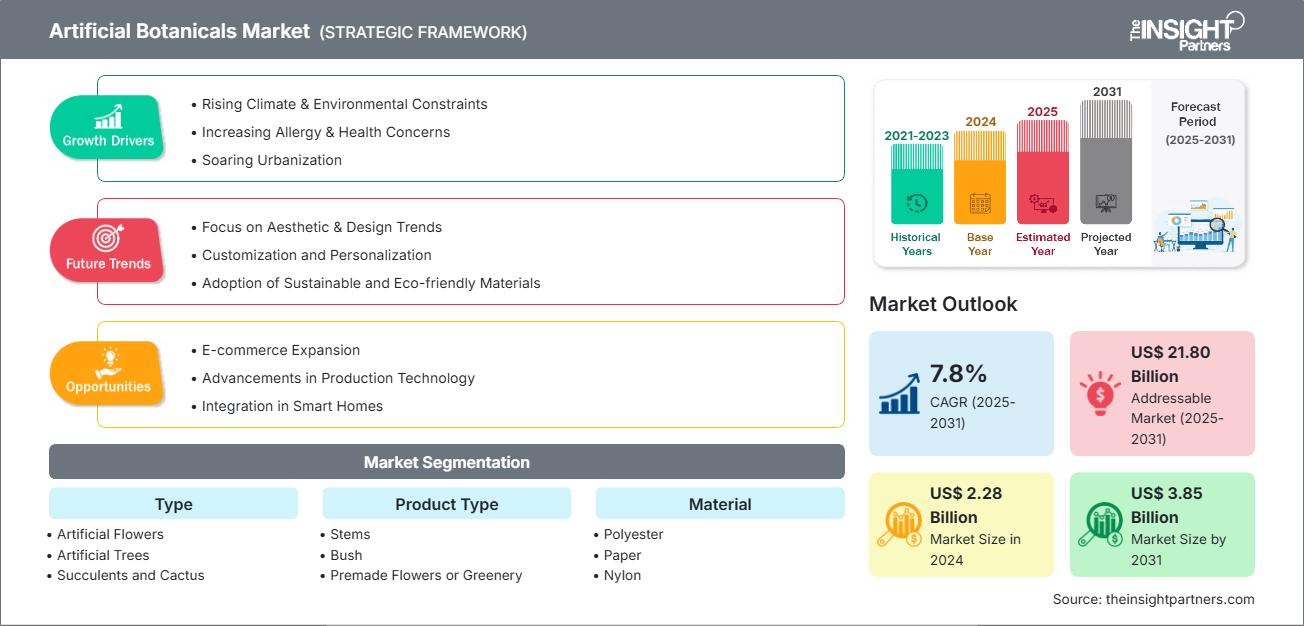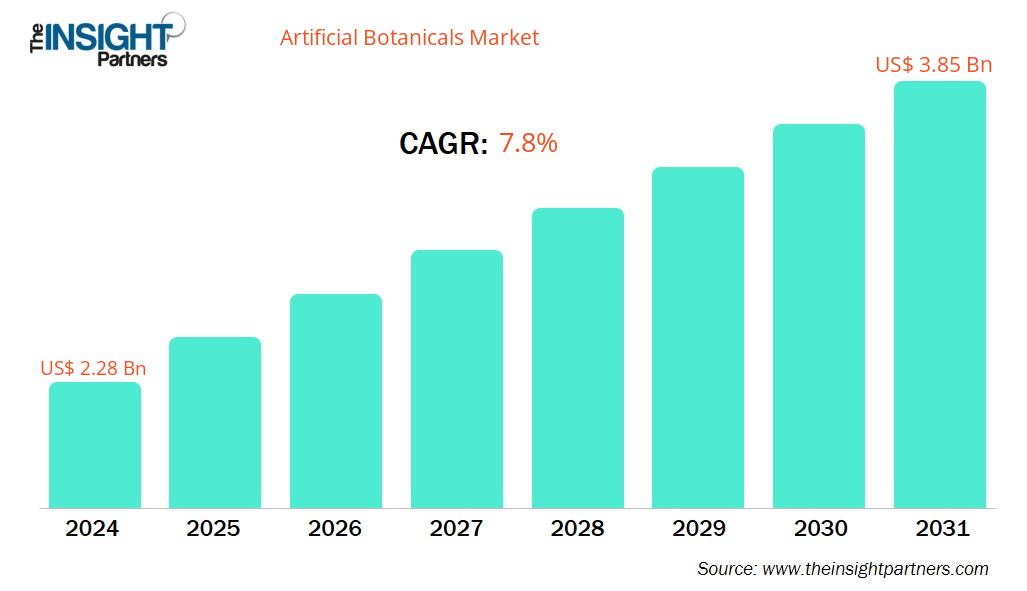人工植物药市场规模预计将从 2024 年的 24.2 亿美元增至 2031 年的 40.9 亿美元。预计 2025 年至 2031 年期间该市场的复合年增长率将达到 7.8%。
人工植物药市场分析
人造植物在家居装饰领域扮演着至关重要的角色。由于人们对美观且视觉吸引力强的产品的需求日益增长,这些产品被广泛用作真实植物和花卉的替代品。消费者深受数字平台内容的影响,例如Instagram和Pinterest上包含各种家居风格创意和产品选择的家居改造视频。这些平台在其内容中广泛使用人造植物,因为它们具有美观且可定制的纹理,并且易于维护,非常适合消费者繁忙的日程安排。这些因素使它们成为更受欢迎且更合适的室内植物和花卉替代品。
人工植物药市场概况
人造植物的制造工艺与天然植物和花卉的纹理、颜色、香味和外观高度相似。它们由塑料、丝绸、乳胶和聚酯纤维等优质材料制成。这些材料使人造花能够保持持久的色彩,更加耐用,适合长期使用,不受季节变化的影响。这些因素使其成为室内装饰、活动、婚礼和节庆场合的理想选择。人造植物也受到某些过敏症消费者的青睐,因为一些室内植物会传播花粉、土壤过敏原或霉菌,这些都可能对消费者的健康构成风险。
您将获得任何报告的免费定制,包括本报告的部分内容、国家级分析、Excel 数据包,以及为初创企业和大学提供优惠和折扣
人工植物药市场:战略洞察

-
获取此报告的顶级关键市场趋势。此免费样品将包括数据分析,从市场趋势到估计和预测。
人工植物药市场驱动因素和机遇
市场驱动因素:
- 城市化进程加快:城市化进程加快和消费者繁忙的工作日程推动了对人工植物药的需求。botanicals.
- 人们对家居装饰的兴趣日益浓厚:人们对美观家居装饰品的兴趣日益浓厚,促进了市场的增长。
- 社交媒体影响力日益增强:社交媒体和 Instagram 和 TikTok 上的数字内容影响力日益增强,推动了市场增长。
- 技术进步:人工植物生产先进技术的发展使其更加现实。
- 日益增长的可持续性关注:消费者对环保和可持续的真实植物替代品的兴趣日益浓厚,促进了市场扩张。
市场机会:
- 电子商务扩张:由于对便利性的需求不断飙升,在线零售行业的扩张促进了市场的增长。
- 可定制产品:人工植物可根据消费者喜好进行定制,并且不受季节供应的影响。
- 对无过敏原问题的关注日益增加:人工植物药对家养宠物和过敏症的益处日益增加,这加剧了需求。
- 融入智能家居:人工植物因其耐用性和低维护性而非常适合智能家居环境。
人工植物药市场报告细分分析
为了更清晰地了解人工植物药市场运作方式、增长潜力和最新趋势,我们将人工植物药市场划分为不同的细分市场。以下是行业报告中使用的标准细分方法:
按类型:
- 人造花:人造花在质地、香味和外观方面与原始花朵非常相似。
- 人造树:人造树包括榕树、棕榈树、盆景树、竹树等。
- 多肉植物和仙人掌:多肉植物和仙人掌因其美观而成为流行的家居装饰选择。
- 其他:其他产品包括挂饰、盆栽、树木、草芦等。
按产品类型:
- 茎:人造茎用于人造花束和 DIY 项目。
- 灌木:灌木人造植物非常适合填充花盆或在生活空间中创造绿色植物。
- 预制鲜花/绿植:这些是用于婚礼和其他节日场合的即用型插花。
- 切花:这些花广泛用于节日场合,模仿鲜切花。
- 其他:包括花环、花圈、人造水果、草等。
按材质:
- 聚酯纤维:聚酯纤维具有良好的染料保持性,可确保颜色持久,不受有限阳光的影响,并且耐磨损。
- 纸张:其重量轻且用途广泛,是生产人工植物药的合适材料。
- 尼龙:尼龙因其柔韧性、强度和光滑的质地而广受欢迎。
- 其他:其他部分包括塑料、聚苯乙烯泡沫、橡胶、丝绸、乳胶和其他材料。
按分销渠道:
- 超市和大卖场:超市和大卖场因其种类繁多且批量折扣而受欢迎。
- 专卖店:这类商店提供定制服务,并提供专家协助挑选人造植物。这些商店包括花店和其他专卖花店。
- 网上零售:便捷的获取和日益增长的便利性需求推动了网上零售渠道对人工植物药的需求。
- 其他:包括出口市场和贸易展览会、便利店、快闪店等。
按地理位置:
- 北美
- 欧洲
- 亚太地区
- 南美洲和中美洲
- 中东和非洲
人工植物药市场区域洞察
Insight Partners 的分析师已详尽阐述了预测期内影响人工植物药市场的区域趋势和因素。本节还讨论了北美、欧洲、亚太地区、中东和非洲以及南美和中美洲的人工植物药市场细分和地理分布。
人工植物药市场报告范围
| 报告属性 | 细节 |
|---|---|
| 2024年的市场规模 | 22.8亿美元 |
| 2031年的市场规模 | 38.5亿美元 |
| 全球复合年增长率(2025-2031) | 7.8% |
| 史料 | 2021-2023 |
| 预测期 | 2025-2031 |
| 涵盖的领域 |
按类型
|
| 覆盖地区和国家 |
北美
|
| 市场领导者和主要公司简介 |
|
人工植物药市场参与者密度:了解其对商业动态的影响
人工植物药市场正在快速增长,这得益于终端用户需求的不断增长,而这些需求的驱动因素包括消费者偏好的演变、技术进步以及对产品益处的认知度不断提高。随着需求的增长,企业正在扩展产品线,不断创新以满足消费者需求,并抓住新兴趋势,从而进一步推动市场增长。

- 获取人工植物药市场主要参与者概览
人工植物药市场份额按地区分析
亚太地区的人工植物药市场正以最快的速度增长。该地区对家居装饰的日益关注推动了这一增长。南美、中美、中东和非洲等新兴市场为人工植物药供应商提供了尚未开发的扩张机会。
各地区人工植物药市场的增长情况各不相同。随着高端消费需求的持续增长,在不断变化的消费格局中,人工植物药已成为全球范围内备受青睐的消费品。以下是各地区市场份额和趋势的总结:
1. 北美
- 市场份额:占据最大市场份额
-
关键驱动因素:
- 越来越注重家居装饰
- 社交媒体影响力日益增强
- 城市化进程加快
- 趋势:整个地区节日期间对人工植物药的需求不断增长
2.欧洲
- 市场份额:占有相当大的市场份额
-
关键驱动因素:
- 健康意识不断提高
- 越来越注重家居美学
- 定制解决方案的需求不断增长
- 趋势:消费者对斯堪的纳维亚室内设计美学的偏好转变
3. 亚太地区
- 市场份额增长最快的地区,市场份额逐年上升
-
关键驱动因素:
- 有利的气候条件
- 城市化进程加快
- 增加可支配收入
- 趋势:越来越关注家居装饰
4. 南美洲和中美洲
- 市场份额:快速发展的不断增长的市场
-
关键驱动因素:
- 扩大网上零售
- 室内植物越来越受欢迎
- 趋势:人们越来越意识到人工植物的健康益处
5.中东和非洲
- 市场份额:虽然较小,但增长迅速
-
关键驱动因素:
- 城市化进程加快
- 恶劣的气候条件
- 趋势:社交媒体影响力增强
人工植物药市场参与者密度:了解其对商业动态的影响
市场密度高,竞争激烈
由于 The Artificial Plants Shop、Sinleen Artificial Plants、Evergreen Trees & Shrubs Ltd、Afloral、Diane James Designs Inc、The Faux Flower Co、Everplant、Lotus Imports Ltd、Floralsilk Ltd、Beliani、Next Retail Ltd、Les Plantes d'Intérieur Véronneau Inc、SilkPlantsDirect、Jamali Garden 和 Trustfloral 等知名企业的存在,竞争十分激烈。
这种激烈的竞争促使公司通过提供以下产品脱颖而出:
- 多样化的产品供应
- 可持续和道德采购
- 有竞争力的定价模式
- 强大的客户支持和轻松的集成
机遇与战略举措
- 专注于研发活动以在市场中脱颖而出
- 通过收购增值糖果品牌扩大全球影响力和能力
- 通过推出可持续产品扩大产品组合
在人工植物药市场运营的主要公司有:
- 人造植物商店
- Sinleen人造植物
- 常青树木和灌木有限公司
- 无花果
- 黛安·詹姆斯设计公司
- 人造花公司
- 常青树
- 莲花进口有限公司
- 花丝有限公司
- 贝利亚尼
免责声明:以上列出的公司没有按任何特定顺序排列。
研究过程中分析的其他公司:
- Next 零售有限公司
- 维罗诺国际植物公司
- SilkPlantsDirect
- 贾玛利花园
- 信托花卉
- 树定位
- 感觉真实
- 亲笔签名的叶子
- 贾玛利花园
- 近乎自然公司
人工植物药市场新闻及最新发展
- RTfact Flowers – 生产能力扩张 RTfact Flowers 在布鲁克兰兹零售中心附近的威布里奇开设了一个新的展厅,拥有 2,000 平方英尺的展示空间、人造树、绿化和室内配件,取代了其已有 18 年历史的 Claygate 展厅。
- Röko – 并购 Röko 收购了 Silk-Ka 的大部分股份,Silk-Ka 是一家领先的欧洲人造花卉和植物设计和分销公司,在荷兰亨厄洛拥有 30 名员工。
人工植物药市场报告覆盖范围和交付成果
《人工植物药市场规模及预测(2021-2031)》报告对市场进行了详细分析,涵盖以下领域:
- 范围内涵盖的所有主要市场领域的人工植物药市场规模和全球、区域和国家层面的预测
- 人工植物药市场趋势以及市场动态,例如驱动因素、限制因素和关键机遇
- 详细的波特五力模型和 SWOT 分析
- 人工植物药市场分析涵盖主要市场趋势、全球和区域框架、主要参与者、法规和最新市场发展
- 行业格局和竞争分析,涵盖市场集中度、热图分析、知名参与者以及人工植物药市场的最新发展
- 详细的公司简介
- 历史分析(2 年)、基准年、预测(7 年)及复合年增长率
- PEST和SWOT分析
- 市场规模、价值/数量 - 全球、区域、国家
- 行业和竞争格局
- Excel 数据集
近期报告
客户评价
购买理由
- 明智的决策
- 了解市场动态
- 竞争分析
- 客户洞察
- 市场预测
- 风险规避
- 战略规划
- 投资论证
- 识别新兴市场
- 优化营销策略
- 提升运营效率
- 顺应监管趋势






















 获取免费样品 - 人工植物药市场
获取免费样品 - 人工植物药市场